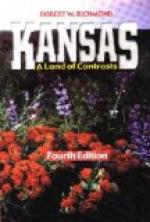Baseball, on the other hand (which, pace, my American friends, is simply glorified rounders), with the exception of school and college teams, is almost wholly practised by professional players; and the place of the county cricket matches is taken by the games between the various cities represented in the National League, in which the amateur is severely absent. The dress, with a long-sleeved semmet appearing below a short-sleeved jersey, is very ugly, and gives a sort of ruffianly look to a “nine” which it might be free from in another costume. The ground is theoretically grass, but practically (often, at least) hard-trodden earth or mud. A match is finished in about one hour and a half. In running for base a player has often to throw himself on his face, and thereby covers himself with dust or mud. The spectators have each paid a sum varying from 1s. or 2s. to 8s. or even 10s. for admission, and are keenly excited in the contest; while their yells, and hoots, and slangy chaff are very different to the decorous applause of the cricket field, and rather recall an association football crowd in the Midlands. As a rule not much sympathy or courtesy is extended to the visiting team, and the duties of an umpire are sometimes accompanied by real danger.[14] Several features of the play seem distinctly unsportsmanlike. Thus, it is the regular duty of one of the batting team, when not in himself, to try to “rattle” the pitcher or fielder by yells and shouts just as he is about to “pitch” or “catch” or “touch.” It is not considered dishonourable for one of the waiting strikers to pretend to be the player really at a base and run from base to base just outside the real line so as to confuse the fielders. On the other hand the game is rapid, full of excitement and variety, and susceptible of infinite development of skill. The accuracy with which a long field will throw to base might turn an English long-leg green with envy; and the way in which an expert pitcher will make a ball deflect in the air, either up or down, to the right or left, must be seen to be believed. A really skilful pitcher is said to be able to throw a ball in such a way that it will go straight to within a foot of a tree, turn out for the tree, and resume its original course on the other side of it!




